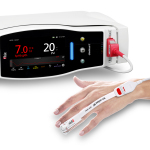Multicenter Study Evaluates Trend Accuracy of Noninvasive, Continuous Masimo SpHb® and Two Invasive Hemoglobin Testing Methods

IRVINE, Calif.–(BUSINESS WIRE)–Masimo (NASDAQ: MASI) announced today that in a multicenter study recently published in the Journal of Clinical Monitoring and Computing, researchers at three institutions – Loma Linda University in California (LLU), the University of California at Irvine (UCI), and Mayo Clinic in Jacksonville, Florida (MCF) – evaluated the trend accuracy of three hemoglobin (Hb) monitoring methods, including noninvasive, continuous Masimo SpHb®.1
Dr. Applegate and colleagues prefaced their investigation by noting that Hb measurement “informs patient-specific perioperative transfusion decisions within the context of symptoms, comorbid conditions, surgical procedure, observed bleeding and hemodynamic performance.” They also noted, however, that “the time needed for blood sampling and analysis can cause Hb measurement to lag clinical situations. In surgical settings in which blood loss may not be apparent or be difficult to estimate, continuous rather than intermittent Hb monitoring could provide earlier warning of decreasing Hb.” Thus, they sought to determine whether noninvasive, continuous hemoglobin monitoring using Pulse CO-Oximetry (SpHb) might provide useful real-time information about changes in Hb.
The researchers compared noninvasive SpHb measurement and two invasive methods of determining intraoperative Hb changes – arterial blood gas CO-oximetry (ABGHb) and point-of-care hemoglobin using arterial blood (aHQHb) – to laboratory determined hemoglobin changes (tHb) for trend accuracy. SpHb was measured using Masimo Radical-7® Pulse CO-Oximeters® with rainbow® fingertip sensors at all sites. Based on the institution, ABGHb was measured using either a Radiometer ABL800, Nova Biomedical CCX or PhOX, or Siemens RAPIDLab 1265; aHQHb was measured with a HemoCue HB 301; and tHb was measured using either a Sysmex XE5000 or Coulter AcT-diff or LH 750, also depending on the institution.
The researchers independently enrolled 135 adult patients undergoing non-cardiac surgery in which arterial catheterization was planned and repeated intraoperative blood gas analysis was expected (51 at LLU, 26 at UCI, and 58 at MFC). During surgery, whenever arterial blood analysis was performed, SpHb (as displayed at the time blood was drawn) was recorded, and samples were analyzed within ten minutes using ABGHb, aHQHb, and tHb. On average, patients had 4 samples obtained (ranging from 2 to 13), with a total of 551 blood gas samples analyzed, providing 416 sequential changes in Hb for trend assessment.
Using modified Bland-Altman analysis, the researchers assessed trend accuracy for the three methods compared to laboratory analysis, calculating mean bias (95% limits of agreement) of 0.10 (-1.14 to 1.35) for SpHb, -0.02 (-1.06 to 1.02) for ABGHb, and 0.003 (-0.95 to 0.95) for aHQHb. Defining a change in SpHb, ABGHb, or aHQHb as ± 0.5 g/dL and a change in tHb as ± 0.25 g/dL, the researchers found that changes in direction agreed with tHb changes in direction as follows: in 94.2% (88.9 – 97.0%) of SpHb changes, in 98.9% (96.1 – 99.7%) of ABGHb changes, and in 99.0% (96.4 – 99.7%) of aHQHb changes.
The researchers concluded, “We found that SpHb, ABGHb and aHQHb changes more than ± 0.5 g/dL have similar correlation to the direction but not necessarily the magnitude of tHb change during surgery. The similar agreement in trend direction suggests that clinicians can choose which to use based on availability or preference, although continuous SpHb monitoring may provide useful ongoing Hb trend information. Continuous noninvasive SpHb decreases exceeding −0.5 g/dL may prompt a decision to obtain a confirmatory tHb measurement if low tHb is clinically suspected, but not replace blood Hb measurement in guiding transfusion decision making.”
Comparing their results to two previous single-center studies involving changes in SpHb compared to changes in tHb,2-3 the researchers noted that their multicenter study produced “similar” results in both cases: one study (of volunteers) found 95.4% SpHb change agreement in 22 samples with tHb < 10.0 g/dL,2 while the other study (of 70 trauma patients) reported bias of -0.05, with limits of agreement of -0.62 to 0.51.3
SpHb is not intended to replace laboratory blood testing. Clinical decisions regarding red blood cell transfusions should be based on the clinician’s judgment considering, among other factors, patient condition and laboratory diagnostic tests using blood samples.
@MasimoInnovates | #Masimo
About Masimo
Masimo (NASDAQ: MASI) is a global medical technology company that develops and produces a wide array of industry-leading monitoring technologies, including innovative measurements, sensors, patient monitors, and automation and connectivity solutions. Our mission is to improve patient outcomes and reduce the cost of care. Masimo SET® Measure-through Motion and Low Perfusion™ pulse oximetry, introduced in 1995, has been shown in over 100 independent and objective studies to outperform other pulse oximetry technologies.4 Masimo SET® has also been shown to help clinicians reduce severe retinopathy of prematurity in neonates,5 improve CCHD screening in newborns,6 and, when used for continuous monitoring with Masimo Patient SafetyNet™ in post-surgical wards, reduce rapid response team activations, ICU transfers, and costs.7-9 Masimo SET® is estimated to be used on more than 100 million patients in leading hospitals and other healthcare settings around the world,10 and is the primary pulse oximetry at 9 of the top 10 hospitals according to the 2019-20 U.S. News and World Report Best Hospitals Honor Roll.11 Masimo continues to refine SET® and in 2018, announced that SpO2 accuracy on RD SET® sensors during conditions of motion has been significantly improved, providing clinicians with even greater confidence that the SpO2 values they rely on accurately reflect a patient’s physiological status. In 2005, Masimo introduced rainbow® Pulse CO-Oximetry technology, allowing noninvasive and continuous monitoring of blood constituents that previously could only be measured invasively, including total hemoglobin (SpHb®), oxygen content (SpOC™), carboxyhemoglobin (SpCO®), methemoglobin (SpMet®), Pleth Variability Index (PVi®), RPVi™ (rainbow® PVi), and Oxygen Reserve Index (ORi™). In 2013, Masimo introduced the Root® Patient Monitoring and Connectivity Platform, built from the ground up to be as flexible and expandable as possible to facilitate the addition of other Masimo and third-party monitoring technologies; key Masimo additions include Next Generation SedLine® Brain Function Monitoring, O3® Regional Oximetry, and ISA™ Capnography with NomoLine® sampling lines. Masimo’s family of continuous and spot-check monitoring Pulse CO-Oximeters® includes devices designed for use in a variety of clinical and non-clinical scenarios, including tetherless, wearable technology, such as Radius-7® and Radius PPG™, portable devices like Rad-67™, fingertip pulse oximeters like MightySat® Rx, and devices available for use both in the hospital and at home, such as Rad-97®. Masimo hospital automation and connectivity solutions are centered around the Iris® platform, and include Iris Gateway®, Patient SafetyNet, Replica™, Halo ION™, UniView™, and Doctella™. Additional information about Masimo and its products may be found at www.masimo.com. Published clinical studies on Masimo products can be found at www.masimo.com/evidence/featured-studies/feature/.
ORi and RPVi have not received FDA 510(k) clearance and are not available for sale in the United States. The use of the trademark Patient SafetyNet is under license from University HealthSystem Consortium.
References
- Applegate RL, Applegate PM, Cannesson M, Peiris P, Ladlie B, and Torp K. Multicenter comparison of three intraoperative hemoglobin trend monitoring methods. J Clin Monit Comput. 3 Dec 2019. https://doi.org/10.1007/s10877-019-00428-3.
- Marques NR, Kramer GC, Voigt RB, Salter MG, and Kinsky MP. Trending, accuracy, and precision of noninvasive hemoglobin monitoring during human hemorrhage and fixed crystalloid bolus. Shock. 2015;44(Suppl 1):45–9. https ://doi.org/10.1097/SHK.00000 00000 00031 0.
- Gamal M, Abdelhamid B, Zakaria D, Dayem OAE, Rady A, Fawzy M, and Hasanin A. Evaluation of noninvasive hemoglobin monitoring in trauma patients with low hemoglobin levels. Shock. 2018;49(2):150–3. https ://doi.org/10.1097/SHK.00000 00000 00094 9.
- Published clinical studies on pulse oximetry and the benefits of Masimo SET® can be found on our website at http://www.masimo.com. Comparative studies include independent and objective studies which are comprised of abstracts presented at scientific meetings and peer-reviewed journal articles.
- Castillo A et al. Prevention of Retinopathy of Prematurity in Preterm Infants through Changes in Clinical Practice and SpO2 Technology. Acta Paediatr. 2011 Feb;100(2):188-92.
- de-Wahl Granelli A et al. Impact of pulse oximetry screening on the detection of duct dependent congenital heart disease: a Swedish prospective screening study in 39,821 newborns. BMJ. 2009;Jan 8;338.
- Taenzer AH et al. Impact of pulse oximetry surveillance on rescue events and intensive care unit transfers: a before-and-after concurrence study. Anesthesiology. 2010:112(2):282-287.
- Taenzer A et al. Postoperative Monitoring – The Dartmouth Experience. Anesthesia Patient Safety Foundation Newsletter. Spring-Summer 2012.
- McGrath SP et al. Surveillance Monitoring Management for General Care Units: Strategy, Design, and Implementation. The Joint Commission Journal on Quality and Patient Safety. 2016 Jul;42(7):293-302.
- Estimate: Masimo data on file.
- http://health.usnews.com/health-care/best-hospitals/articles/best-hospitals-honor-roll-and-overview.
Forward-Looking Statements
This press release includes forward-looking statements as defined in Section 27A of the Securities Act of 1933 and Section 21E of the Securities Exchange Act of 1934, in connection with the Private Securities Litigation Reform Act of 1995. These forward-looking statements include, among others, statements regarding the potential effectiveness of Masimo SpHb® and Radical-7®. These forward-looking statements are based on current expectations about future events affecting us and are subject to risks and uncertainties, all of which are difficult to predict and many of which are beyond our control and could cause our actual results to differ materially and adversely from those expressed in our forward-looking statements as a result of various risk factors, including, but not limited to: risks related to our assumptions regarding the repeatability of clinical results; risks related to our belief that Masimo’s unique noninvasive measurement technologies, including Masimo SpHb and Radical-7, contribute to positive clinical outcomes and patient safety; risks related to our belief that Masimo noninvasive medical breakthroughs provide cost-effective solutions and unique advantages; as well as other factors discussed in the “Risk Factors” section of our most recent reports filed with the Securities and Exchange Commission (“SEC”), which may be obtained for free at the SEC’s website at www.sec.gov. Although we believe that the expectations reflected in our forward-looking statements are reasonable, we do not know whether our expectations will prove correct. All forward-looking statements included in this press release are expressly qualified in their entirety by the foregoing cautionary statements. You are cautioned not to place undue reliance on these forward-looking statements, which speak only as of today’s date. We do not undertake any obligation to update, amend or clarify these statements or the “Risk Factors” contained in our most recent reports filed with the SEC, whether as a result of new information, future events or otherwise, except as may be required under the applicable securities laws.
Contacts
Masimo
Evan Lamb
949-396-3376
elamb@masimo.com


